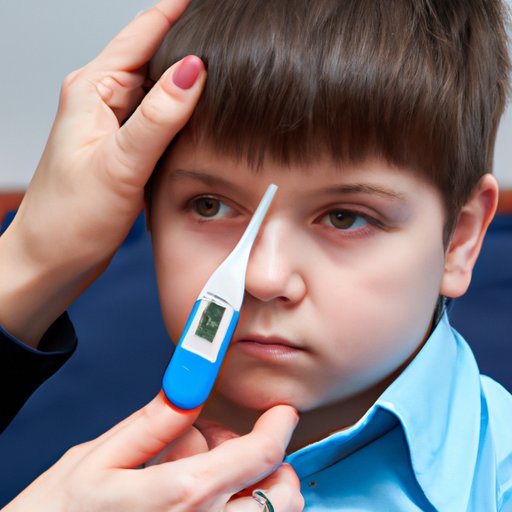
Introduction
A child with a fever can be a cause for concern, especially for new parents. A fever is a natural response by the body to fight off an infection or illness. However, when a child’s temperature rises above 100.4°F, it can become uncomfortable and worrisome for parents. This article will provide parents with information on how to safely and effectively bring down a fever in a child.
Home Remedies for Reducing Fever in a Child
Using natural and home remedies to reduce fever in a child can have many benefits, including avoiding the side effects of medication, saving money, and reinforcing a parent’s caregiving role. Some effective home remedies for reducing fever in a child include:
Placing a cool, damp washcloth on their forehead:
Wet a washcloth with cool water and place it on your child’s forehead. This will help bring down their body temperature and soothe them.
Giving them a lukewarm bath:
Fill the bathtub with lukewarm water and let your child soak in it for 15-20 minutes. Do not use cold water, as this can cause shivering and increase the body’s temperature.
Keeping them hydrated by drinking plenty of fluids:
Encourage your child to drink lots of fluids such as water or electrolyte solutions like Gatorade or Pedialyte. This will help prevent dehydration, which can occur with a fever.
When using these home remedies, be sure to follow appropriate guidelines and apply them properly. Avoid using excessively cold water or alcohol as it can cause harm to the child.
Over-the-Counter Medications for Reducing Fever in a Child
There are many over-the-counter (OTC) medications available to reduce fever in children. These include acetaminophen (Tylenol) and ibuprofen (Advil or Motrin). It is important to choose the appropriate medication for the child’s age and weight and follow the proper dosing instructions. Some precautions when giving OTC medications include:
– Consult with a doctor about the safest dosage for your child
– Do not give aspirin to a child
– Watch for any adverse reactions such as an allergic reaction
– Avoid using multiple medications to avoid overdose
When to Visit a Doctor Regarding a Fever in a Child
While most fevers are not serious, there are situations where the symptoms require medical attention. It is important to be able to recognize these signs to prevent further complications. Some signs to look out for include:
– A fever that lasts longer than three days
– A fever that spikes above 103°F
– Unexplained rashes on the skin
– Any signs of breathing difficulties
– Loss of consciousness
– Seizures
If your child is experiencing any of these symptoms or if their condition worsens despite using home remedies or medication, then it is time to seek medical attention.
Comfort Measures for Reducing Fever in a Child
It is essential to prioritize your child’s comfort when they have a fever. Dressing your child in loose, breathable clothing can help break the fever and help them feel more comfortable. It is also important to maintain a cool indoor environment by turning on the air conditioning or using a fan. You can also place a wet towel over the fan to circulate cool air throughout the room.
Cooling Products for Reducing a Fever in a Child
There are different cooling products available that can help reduce a child’s body temperature. Cooling pads, blankets, and fans can be useful in bringing down your child’s body temperature and making them feel more relaxed. It is important to use these products safely and make sure your child does not become too cold.
Monitoring Your Child with a Fever
It is crucial to monitor your child’s temperature and symptoms regularly when they have a fever. It can be a sign of an underlying issue that needs attention. Parents should keep a record of their child’s temperature and track their symptoms and behavior.
If your child’s condition worsens or they develop any additional symptoms, it is important to contact a doctor.
Conclusion
In conclusion, bringing down a fever in a child can be a stressful and challenging situation for any parent. However, by using home remedies, OTC medication, and comfort measures, it is possible to reduce a child’s fever and make them feel more relaxed. Be sure to seek medical attention when necessary and prioritize your child’s comfort by keeping them hydrated and maintaining a cool environment. With proper care and attention, your child should recover from a fever in no time.





